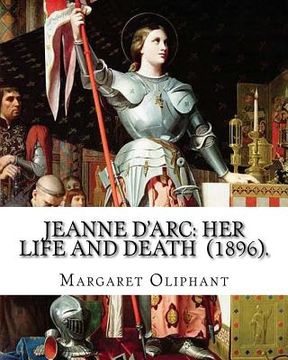Jeanne D'Arc: her life and death (1896). By: Margaret Oliphant: Jeanne D'Arc is considered a heroine of France for her role during t (in English)
Synopsis "Jeanne D'Arc: her life and death (1896). By: Margaret Oliphant: Jeanne D'Arc is considered a heroine of France for her role during t (in English)"
Joan of Arc (French: Jeanne d'Arc 6 January c. 1412 - 30 May 1431), nicknamed "The Maid of Orléans" (French: La Pucelle d'Orléans), is considered a heroine of France for her role during the Lancastrian phase of the Hundred Years' War and was canonized as a Roman Catholic saint. Joan of Arc was born to Jacques d'Arc and Isabelle Romée, a peasant family, at Domrémy in north-east France. Joan said she received visions of the Archangel Michael, Saint Margaret, and Saint Catherine of Alexandria instructing her to support Charles VII and recover France from English domination late in the Hundred Years' War. The uncrowned King Charles VII sent Joan to the siege of Orléans as part of a relief mission. She gained prominence after the siege was lifted only nine days later. Several additional swift victories led to Charles VII's coronation at Reims. This long-awaited event boosted French morale and paved the way for the final French victory.On 23 May 1430, she was captured at Compiègne by the Burgundian faction, which was allied with the English. She was later handed over to the English and put on trial by the pro-English Bishop of Beauvais Pierre Cauchon on a variety of charges. After Cauchon declared her guilty she was burned at the stake on 30 May 1431, dying at about nineteen years of age. In 1456, an inquisitorial court authorized by Pope Callixtus III examined the trial, debunked the charges against her, pronounced her innocent, and declared her a martyr. In the 16th century she became a symbol of the Catholic League, and in 1803 she was declared a national symbol of France by the decision of Napoleon Bonaparte.She was beatified in 1909 and canonized in 1920. Joan of Arc is one of the nine secondary patron saints of France, along with Saint Denis, Saint Martin of Tours, Saint Louis, Saint Michael, Saint Rémi, Saint Petronilla, Saint Radegund and Saint Thérèse of Lisieux. Joan of Arc has remained a popular figure in literature, painting, sculpture, and other cultural works since the time of her death, and many famous writers, filmmakers and composers have created works about her. Cultural depictions of her have continued in films, theater, television, video games, music, and performances to this day........................................... Margaret Oliphant Wilson Oliphant (born Margaret Oliphant Wilson) (4 April 1828 - 20 June 1897), was a Scottish novelist and historical writer, who usually wrote as Mrs. Oliphant. Her fictional works encompass "domestic realism, the historical novel and tales of the supernatural". Life: The daughter of Francis W. Wilson (c. 1788 - 1858), a clerk, and his wife, Margaret Oliphant (c. 1789 - 17 September 1854), [3] she was born at Wallyford, near Musselburgh, East Lothian, and spent her childhood at Lasswade (near Dalkeith), Glasgow and Liverpool. As a girl, she constantly experimented with writing. In 1849 she had her first novel published: Passages in the Life of Mrs. Margaret Maitland. This dealt with the Scottish Free Church movement, with which her parents had sympathised, and which had met with some success. It was followed by Caleb Field in 1851, the year in which she met the publisher William Blackwood in Edinburgh and was invited to contribute to Blackwood's Magazine. The connection would last for her lifetime, during which she contributed well over 100 articles, including a critique of the character of Arthur Dimmesdale in Nathaniel Hawthorne's The Scarlet Letter. In May 1852, she married her cousin, Frank Wilson Oliphant, at Birkenhead, and settled at Harrington Square, now in Camden, London. Her husband was an artist working mainly in stained glass. Three of their six children died in infancy. The father himself developed alarming symptoms of consumption (tuberculosis). For the sake of his health they moved in January 1859 to Florence, and then to Rome, where he died....

